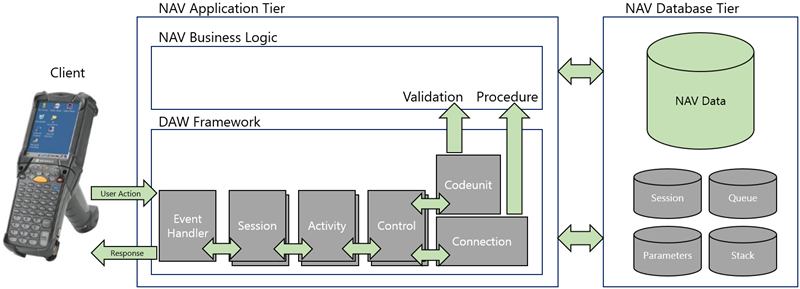Microsoft Dynamics NAV Documentation
Framework Overview
Central to the NAV Anywhere Framework is the NAV Anywhere Portal. Utilizing the NAV Anywhere NAV Web service to connect to Dynamics NAV, the NAV Anywhere Portal carries Dynamics NAV into the mobile world. Designed specifically to work flawless with any mobile device, the NAV Anywhere Portal presents the user with an attractive, fast and reliable user interface. In addition, the user interface is designed to make the most of the mobile device, providing a clutter free view of the application and making full use of additional resources like barcode scanners and RF tag readers to improve user productivity.
The following figure shows the overall architecture and the components that constitute the
NAV Anywhere® Mobile Business Solution:

Many mobile devices have a limited implementation of their web browser due to their design and configuration, making ordinary HTML based solutions unsuitable for use on a mobile device. The NAV Anywhere® Framework will run on any device with a browser, and fully supports using multiple device types and form factors simultaneously.
The system and hardware requirements (refer to the Installation Guide) for each component must be met before installing. When you have determined that your host environment meets the requirements that are provided in the following topics, proceed to the appropriate installation section.
This guide deals mostly with configuring and modifying applications built within the NAV Anywhere Framework. For details on installation and configuration of the Portal, Web service and Framework in NAV, please refer to the Installation Guide.
The Framework in Microsoft Dynamics NAV
The Framework in Microsoft Dynamics NAV consists of a configurator that enables you to create a mobile user interface. The Framework also possesses the logic to interpret and process the request from mobile users and create a response. This is used to interface with Microsoft Dynamics NAV business logic, allowing the user to validate or query data, call Microsoft Dynamics NAV objects to perform registrations, etc.

Above is a diagram showing how the different parts work together, and how the framework interacts with the rest of Microsoft Dynamics NAV.
User actions are received from the Mobile Portal (through the NAV Anywhere Web service).
The event handler looks up the session that goes with the user (or instantiates a new one if the user is not logging in) and passes the event on to the Application. The event handler then processes the request from the Portal, finds the next step in the process, creates a response and passes it to the Portal.
As the Framework exists in the Dynamics NAV Application tier, it can validate user input, register data, or call other NAV business logic.
